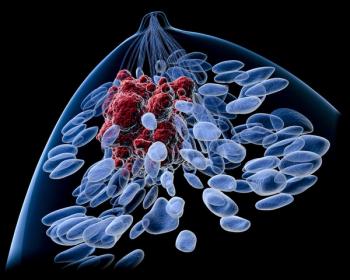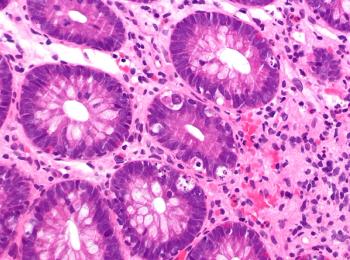
Ultra-Hypofractionated RT Shows Control, Tolerability in Elderly Breast Cancer
Bin Gui, MD, discussed how ultra-hypofractionated radiotherapy may be a convenient treatment option for elderly patients with early breast cancer.
Although ultra-hypofractionated radiotherapy (UHFRT)—a regimen delivered in 5 fractions—has demonstrated efficacy in controlling local recurrence among those with early-stage breast cancer, previous research did not clarify the potential therapeutic role this modality may play among an older subset of patients. Bin Gui, MD, and coinvestigators sought to address this potential gap and determine whether this elderly population may be suitable candidates to undergo a shorter course of radiotherapy.
CancerNetwork® spoke with Gui, a fourth-year radiation oncology resident at the Northwell Health Cancer Institute, about findings from a study he presented at the
In this study, Gui and his colleagues administered treatment with UHFRT as a whole-breast radiation regimen based on the phase 3 FAST-Forward trial (ISRCTN19906132) or as accelerated partial breast irradiation (APBI).2 Among 71 patients with a median age of 73 years, UHFRT with or without endocrine therapy yielded no ipsilateral breast tumor recurrence.
“The older patients with more comorbidities and intolerance of endocrine therapy are ideal for these radiation regimens with UHFRT,” Gui stated. “These regimens [may] offer patients great options to [improve] local control with low toxicity rates. Further prospective studies are necessary to confirm these initial findings.”
Gui detailed the methodology surrounding his research and highlighted other efficacy and safety findings supporting the potential use of UHFRT among an older breast cancer population.
CancerNetwork: What is the background for assessing UHFRT in older patients with early-stage breast cancer?
Gui: UHFRT—which means [approximately] a week of radiation treatments, generally in 5 fractions—has been shown to be effective in controlling local recurrence in patients with early-stage breast cancer per the phase 3 FAST-Forward trial and the APBI trials. However, its role in a subset of older patients was not specifically reported, and as we know from the phase 3 PRIME II study [ISRCTN95889329], it offers an option for older patients to omit the radiation.3 However, many older patients have diminished compliance with endocrine therapy, which was crucial in the PRIME II study.
[Our] study aimed to investigate the initial outcomes of UHFRT in older patients with low-risk breast cancer who were potential candidates for omission of radiation.
What do findings show about the efficacy of UHFRT among this patient population?
Gui: Over 1000 patients with early-stage breast cancer were treated in our center within the past 4 years. Seventy-one patients met the low-risk inclusion criteria and were treated with either whole breast FAST-Forward regimen or the APBI regimen.
The median tumor size was 0.8 cm. [Although] the compliance with radiation was 100%, the compliance with the endocrine therapy was only 24% either due to refusal or termination of endocrine therapy due to adverse effects. We had a median follow-up of 10 months. There was no local recurrence in the entire cohort.
How well tolerated was this treatment regimen?
There were no grade 3 or 4 toxicites. The grade 2 acute toxicity, late toxicity, and cosmetic outcomes were [all] low for radiation plus endocrine therapy, or radiation alone.
As I mentioned [earlier], many patients have an intolerance to endocrine therapy. In this study, we did find that there was no difference in the acute toxicity, late toxicity, and cosmetic outcomes between the radiation plus endocrine therapy [arm] or the radiation alone [arm]. That can give an option for the patient to think about what's the best treatment enrichment for them.
What do you hope your colleagues take away from this presentation?
Gui: In conclusion, this study demonstrates that UHFRT with either the FAST-Forward or APBI regimens offers a convenient and easily tolerated treatment approach for older patients who [want] to reduce the rate of their local recurrence. Furthermore, [apart from patients having] diminished compliance with endocrine therapy, their compliance with UHFRT was 100%. These regimens [may] offer patients great options to [improve] local control with low toxicity rates. Further prospective studies are necessary to confirm these initial findings.
References
- Gui B, Ojo O, Ottensoser L, et al. Ultra-hypofractionated radiation in older patients with low risk early-stage breast cancer. Presented at the 2024 American Society for Radiation Oncology (ASTRO) Annual Meeting; September 29 – October 2, 2024; Washington, DC. Poster 2683
- Brunt AM, Haviland JS, Wheatley DA, et al. One versus three weeks hypofractionated whole breast radiotherapy for early breast cancer treatment: the FAST-Forward phase III RCT. Health Technol Assess. 2023;27(25). doi:10.3310/WWBF1044
- Kunkler IH, Williams LJ, Jack WJL, et al. Breast-conserving surgery with or without irradiation in early breast cancer. N Engl J Med. 2023;388(7):585-594. doi:10.1056/NEJMoa2207586
Newsletter
Stay up to date on recent advances in the multidisciplinary approach to cancer.

















































































